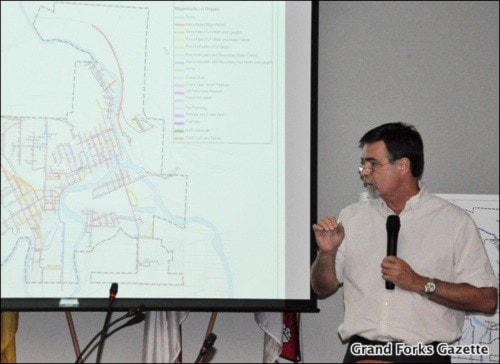The City of Grand Forks received a report on the condition of the city’s roads after much concern about its aging status during a city council meeting on Sept. 4.
Michael Trickey and his team from Strategic Infrastructure Management Inc. from West Kelowna began reviewing the city’s roads in July and looked at which ones needed to be fixed and what should be done with them.
“We looked at the safety and the condition of the road, and we looked at any drainage problems,” Trickey explained. “We did all the field inspection sheets, so where all the roads are geographically, and all the information about that road, such as the condition of it and what we found out. Then we looked at whether you had to rebuild it, which is the most expensive thing to do, then resurface or is there something you can do to maintain it.”
According to Trickey, Grand Forks has around 70 kilometres of road. Of the 70 kilometres, 10 kilometres are in very good condition.
Around 38 kilometres are considered to be in fair condition, which Trickey notes would be a concern in five to 10 years.
The remaining 22 kilometres are in poor condition and should be either reconstructed or resurfaced.
“There were also some roads that really didn’t have a lot of activity on them, and it was very remote and unpaved; for those I would recommend running them until they fail because there isn’t much traffic and there are barely any homes,” he added. “We found around 2.8 kilometres of roads that we thought you should consider transferring because you’re not using it. That’s good news because it means you don’t have to worry about those roads.”
However, Trickey pointed out that rather than spending a lot of money on reconstruction, he suggested starting a crack seal program to deal with cracks in the road that haven’t been sealed for several years.
“We think if you crack sealed your roads, and had a major program for it, you wouldn’t have to resurface (the roads) for quite a while and it would save some money that can be diverted to your sanitary and sewer water system,” he said.
For reconstruction, which involves digging up the entire portion of the road and rebuilding it, it would cost $88 per metre square.
Trickey noted that there are three kilometres that require reconstruction, which is roughly $900,000 a kilometre and $2.2 million in total to complete all three kilometres.
“If you resurface, which would just change the surface rather than dig out all the gravel as well, it’s going to cost you $42 per square metre, that’s about $400,000 per kilometre,” he said, adding there is around nine kilometres that should be considered for resurfacing.
“However, for crack seal, it’s only $2.95 per linear metre – and there is around 50 kilometres of roads that are in fair condition in the city.”
Trickey also pointed out that the city’s decision would depend on what they find from the sewer and pipeline investigation.
“If you find some pipes that need replacing, you may decide to reconstruct that as well,” he said. “You need to consider doing it now, or soon. The costs (to reconstruct), which would include construction, administration and design, would cost you $2.2 million, and $3.34 million for the resurfacing. For crack sealing, to do 50 kilometres may only cost you $50,000.”
Mayor Brian Taylor was pleased by the report and what the overall costs fixing the city’s roads would potentially cost.
“This is something we can do without a government grant at this point because we don’t have money for the bigger projects,” he said.
The City of Grand Forks is already looking into multi-utility projects that would include updates to the sewer and road infrastructure. The report notes that of the 70 kilometres of road in the city, only 12 kilometres need to be looked at.
Cecile Arnott, the city’s chief financial officer, noted that spending money now can save thousands for future projects.
“One of the options we’re bringing forward is to mirror the road assessment with the sewer assessment because this is a known savings and a known risk,” she said. “There’s no way we should reconstruct or resurface an area without checking the sewers underneath because you don’t want to go through all that and not have checked.”
Arnott is pleased that the city’s good maintenance plan “to get to it and doing the right thing quickly will save you in the future” has been working.
The final report will be available by the end of September.
